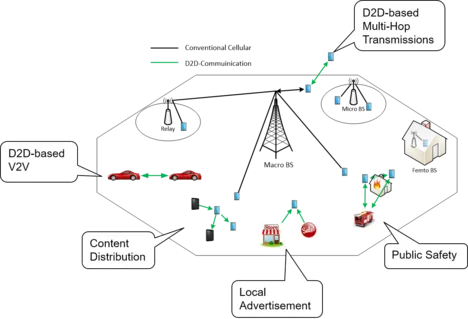Network Management and Interference Coordination for Resource Efficiency in Device-to-Device Communication
| Funding Agency: | DFG |
| Duration: | 2 years, 01.03.2014 - 15.4.2016 |
| Partners: | Fachgebiet Methoden der Signalverarbeitung (MSV), TU Munich |
| Contact Persons: | Markus Klügel (markus.kluegel(at)tum.de) |
Scope of Project

Cellular Networks
In the last decades, cellular networks have developed from single-purpose networks to highspeed data networks. This has shifted the typical application scenario from speech towards multimedia and internet access. The infrastructure of the radio access network (RAN) has become very diverse and no longer consists of a single base station but also includes relays, micro- and femto-base stations, as is shown in the picture. For this diverse structure, the concepts used for resource-, power- and interference management have to be re-thought.
Device-to-Device Communication
A consequent next step in these diverse cellular networks is to allow direct communications between the user devices, which are controlled by the cellular base station. This is referred to as Device-to-Device (D2D) communication. This step allows new application scenarios, as an ad-hoc underlay network is formed in the cellular network, breaking the star-like communication topology. It allows for location- and context-aware applications and peer-to-peer scenarios on a new scale.
From a management perspective, when source and sink of a traffic flow are located nearby, direct communication can be a better choice than a communication passing through the base station and the core network of the provider. The close location of nodes allows for high data rates at low latency and low energy consumption (proximity-gain, [1]). As only one direct link is required, compared to up- and downlink in cellular communication, less resources are used in overall (hop-gain, [1]). Finally, by reducing transmit power, interference between users is lowered so much that a reuse of transmission resources within the same cell is possible (reuse-gain, [1]). However, the exact amount of "gain" achieved by introducing direct links is not easily specified. The exact benefits need to be quantified to manage links correctly.
In the D2D-scenario, resource allocation, power- and interference management are even more challenging than for infrastructure networks due to moving devices and the changing nature of wireless links. Finding mechanisms that allow a safe integration of D2D-communication into cellular networks and how to design application scenarios that benefit from direct traffic are a research area which receives increasing attention.
Our Research focuses on the modeling of resource efficiency, topological considerations, efficient power control and resource allocation. In cooperations, the joint interaction of an application overlay with a D2D underlay as well as D2D communication between vehicles is considered.
[1] G. Fodor, E. Dahlman, G. Mildh, S. Parkvall, N. Reider, G. Miklós, and Z. Turányi. Design aspects of network assisted device-to-device communications. IEEE Communications Magazine, 50(3):170–177, 2012.